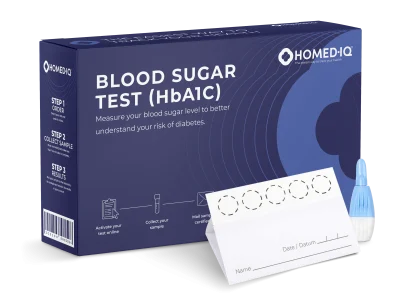Type 1 diabetes, also known as diabetes mellitus, is a condition in which the pancreas does not produce insulin. Insulin is a hormone the body uses to allow glucose (sugar) from your food to enter body cells. Without sufficient insulin, glucose builds up in the bloodstream. This can cause life-threatening complications. To prevent this, people with type 1 diabetes must take insulin daily. This can be done via injections or an insulin pump that must be carried. Individuals with type 1 diabetes cannot live without regularly administered insulin to allow glucose to leave the bloodstream and enter body cells.
Type 1 diabetes usually develops during childhood or adolescence, but it can develop at any age. Interested in checking for potential type 1 or type 2 diabetes? Homed-IQ’s Blood Sugar Test allows users to test their HbA1c from home. HbA1c is a marker of average blood sugar levels over the past three months and is used to diagnose diabetes.
Table of Contents
Read on to learn the answers to some of the most common questions about type 1 diabetes.
- What causes type 1 diabetes?
- Symptoms of type 1 diabetes
- Diagnosing type 1 diabetes
- What foods should you avoid with type 1 diabetes?
- What is the difference between type 1 and type 2 diabetes?
- Complications of type 1 diabetes
- Life expectancy of type 1 diabetes
What causes type 1 diabetes?
Unlike type 2 diabetes in which the body becomes resistant to insulin over time, the lack of insulin in type 1 diabetes occurs due to the body destroying its own insulin-producing cells by mistake. This is also known as an autoimmune reaction. The reason why this occurs is still largely unknown. Research has identified certain genes that make people more likely to develop type 1 diabetes. However, not everyone with this gene will go on to develop diabetes. Scientists believe that an environmental trigger, such as a virus, may also play a role in the development of type 1 diabetes (CDC, 2023).
Can type 1 diabetes be prevented?
While type 2 diabetes is often linked to certain preventable factors such as diet and physical activity levels, there is no known way to prevent type 1 diabetes. It is possible for anyone to develop type 1 diabetes, although most cases occur before age 40 (NHS, 2023).
What are the symptoms of type 1 diabetes?
Symptoms of type 1 diabetes can occur suddenly and may include:
- Losing weight for no apparent reason
- Extreme thirst
- Frequent urination
- Blurred vision
- Being more prone to illness
- Experiencing extreme hunger or a lack of appetite
- Being tired often
Source: Mayo Clinic, 2023
While these symptoms can be a sign of diabetes, they can also be due to other medical conditions. If you are concerned about potential diabetes symptoms, speak to your doctor. They can perform blood tests to check your blood sugar levels and determine the cause of your symptoms.
Undiagnosed or untreated type 1 diabetes can lead to a life-threatening complication called diabetes-related ketoacidosis (DKA). Seek emergency medical care if you are experiencing any of the following symptoms:
- Fruity-smelling breath
- Confusion
- Abdominal pain
- Nausea and vomiting
- Rapid breathing
- Drowsiness or loss of consciousness
Source: CDC, 2022
How is type 1 diabetes diagnosed?
Both type 1 and type 2 diabetes are typically diagnosed through blood tests that measure blood sugar levels. These tests include:
- Glycated Hemoglobin (HbA1C): This blood test measures the average blood sugar level over the past two to three months. An A1C level of 6.5% or higher on two separate tests indicates diabetes.
- Fasting Blood Sugar Test: This test measures blood sugar after fasting (not eating) overnight. A fasting blood sugar level lower than 100 mg/dL is normal. A level of 100 to 125 milligrams per deciliter (mg/dL) indicates prediabetes, and 126 mg/dL or higher on two separate tests suggests diabetes.
- Random Blood Sugar Test: In this test, a blood sample is taken at a random time, regardless of when the last meal was eaten. A random blood sugar level of 200 mg/dL or higher suggests diabetes, especially if accompanied by other signs and symptoms of diabetes.
Source: Mayo Clinic, 2023
Homed-IQ’s Blood Sugar Test allows users to check their HbA1c levels from home. This laboratory test can be used to check for signs of diabetes or ensure previously diagnosed diabetes is well-controlled.
-

Blood Sugar Test (HbA1c)
€35,00
What foods should you avoid with type 1 diabetes?
Generally, people living with type 1 diabetes can eat anything, as long as their blood sugar levels remain in check. However, having a healthy and balanced diet without too many carbs or sugary foods helps ensure that blood glucose levels remain stable and reduces the risk of diabetes-related complications, including heart disease and stroke.
Regardless of diet, the amount of insulin a type 1 diabetic takes must be well matched to the number of carbohydrates and/or sugary products they eat or drink. Recently, managing insulin has become easier with the development of insulin pumps and monitors that track and administer insulin automatically.
Nutrition tips for type 1 diabetes
- Eat plenty of fibre. Fibre ensures a slower rise in blood glucose levels.
- Limit your intake of processed carbohydrates such as white bread, rice, or white pasta.
- Avoid sugary drinks and added sugars. These can cause spikes and fluctuations in your blood glucose levels.
- Do not drink more than 1 glass of alcohol per day.
- Eat oily fish once a week.
- Limit your intake of saturated fats.
While eating well with type 1 diabetes can initially seem daunting, making gradual changes over time can help you adjust and better control your blood sugar. If you have type 1 diabetes and need help with your diet, consult your doctor or a dietitian for advice on how to build a meal plan that keeps your blood sugar stable.
What is the difference between type 1 and type 2 diabetes?
Unlike type 1 diabetes, people with type 2 diabetes still produce insulin. However, their body does not respond well to it. This is also known as insulin resistance. As a result, the body cells do not obtain enough glucose from the blood and blood sugar levels rise. Obesity, genetics and old age are risk factors for type 2 diabetes. It is expected that by 2040 more than 71.1 million adults will have type 2 diabetes in Europe, thousands of whom do not know they have it (International Diabetes Federation, 2020). This is why it is important for healthy adults to periodically check their blood sugar levels, even without obvious symptoms.
Type 2 diabetes makes up 90-95% of all diabetes diagnoses (CDC, 2023). If you have type 2 diabetes, you will usually first receive diet and exercise advice and/or medications to help control your blood sugar. It is usually not necessary to use insulin right away. In contrast, Type 1 diabetes requires immediate and lifelong treatment with insulin. Both type 1 and type 2 diabetes benefit from a healthy lifestyle to limit the chances of diabetes complications and promote blood sugar control.
Is type 1 diabetes serious?
If type 1 diabetes is not diagnosed in time or is not treated correctly, it can cause serious complications that can affect major organs in the body. These organs include the heart, blood vessels, nerves, eyes and kidneys. Maintaining a normal blood sugar level can lower the risk of many complications and allow people with diabetes to live a healthy life.
What are possible complications of type 1 diabetes?
Type 1 diabetes, if not properly managed, can lead to a range of complications, some of which can be serious or even life-threatening. The potential complications include:
- Cardiovascular Disease: Diabetes increases the risk of various cardiovascular (heart) problems such as coronary artery disease, heart attack, stroke, atherosclerosis (narrowing of the arteries), and high blood pressure.
- Nerve Damage (Neuropathy): High blood sugar can injure the walls of the blood vessels that feed the nerves, especially in the legs. This can cause tingling, numbness, pain, and loss of sensation in the limbs over time.
- Pregnancy Complications: High blood sugar levels can be dangerous for both the mother and the baby. The risk of miscarriage, stillbirth, and birth defects increases when diabetes is not well-controlled.
- Kidney Damage (Nephropathy): The kidneys contain millions of tiny blood vessels that filter waste from the blood. Diabetes can damage this delicate filtration system, leading to kidney failure or end-stage kidney disease, which may require dialysis or a kidney transplant.
- Eye Damage: Diabetic retinopathy can damage the blood vessels of the retina, potentially leading to blindness. It also increases the risk of other serious vision conditions, such as cataracts and glaucoma.
- Foot Damage: Diabetic nerve damage or poor blood flow to the feet increases the risk of various foot complications. Left untreated, cuts and blisters can become serious infections, which may require toe, foot, or leg amputation.
- Skin and Mouth Conditions: Diabetes can make people more susceptible to skin and mouth problems, including bacterial and fungal infections.
Source: Mayo Clinic, 2023
What is the life expectancy of people with type 1 diabetes?
The Dutch Institute for Public Health and Environment (RIVM) found that the life expectancy of a person aged 45 with type 1 diabetes is on average 13 years lower than that of a person without diabetes (RIVM, 2021). As people age, the life expectancy gap between those with and without type 1 diabetes narrows. The chance of dying prematurely for people between the ages of 45 and 60 with type 1 diabetes is about five times greater than for people without diabetes (RIVM, 2021). By taking steps to manage blood sugar levels and reduce the risk of complications, people with type 1 diabetes can live longer and healthier lives.





